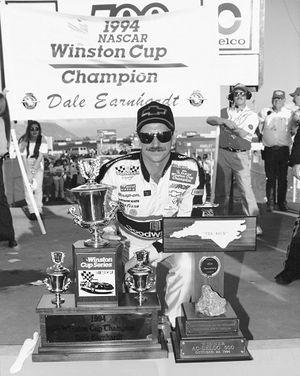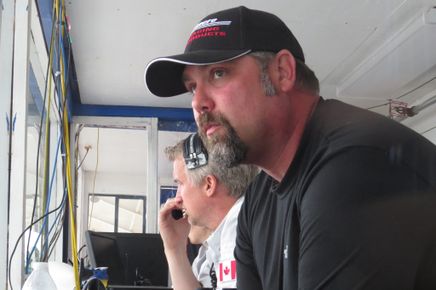Dale Earnhardt: Dominance at Daytona
This weekend marks the 10th anniversary of Dale Earnhardt passing at Daytona International Speedway. Many in the sport look back on the legacy of a NASCAR Hall of Fame entry.
Courtesy: NASCAR Media Relations
DAYTONA BEACH, Fla. (Feb. 15, 2011) — NASCAR returns this weekend. And around all the racing and adjoining pageantry, the sport will remember one of its legends.
Ten years ago this weekend, NASCAR lost Dale Earnhardt, a man who practically owned Daytona International Speedway’s high banks.
Earnhardt, who posted a track record 34 victories over 21 seasons, was without question Daytona’s dominant driver of the 1980s and 1990s.
He won at least once a seasonfor 10 consecutive years from 1990 and 1999, including the 1998 Daytona 500, and spent nearly as much time in Victory Lane as behind the wheel of his iconic, Richard Childress-owned black No. 3 Chevrolet and other competition vehicles.
Earnhardt, who died at age 49 following a final lap accident in the Feb. 18, 2001 Daytona 500, was seemingly luckless in the “Great American Race,” finishing second four times before finally winning the 500. Sure victories slipped away due to bizarre circumstances, ranging from a seagull-damaged front fender to a last-lap flat tire.
Still, the seven-time NASCAR Sprint Cup Series champion was hands-down the favorite every time the green flag waved in Daytona. He twice won the Coke Zero 400 Powered by Coca-Cola and captured the Gatorade Duel at Daytona a dozen times including every qualifying race between 1990 and 1999.
Earnhardt won the NASCAR Nationwide Series DRIVE4COPD 300 seven of the 15 times he competed – capped by the final five races he entered between 1990 and 1994.
He finished outside the top five in the Budweiser Shootout at Daytona only once winning the non-points race six times including 1980, the first year Earnhardt became eligible.
His results in the now discontinued International Race of Champions were similar: six victories in 13 starts against stars of both international and domestic racing series.
Earnhardt’s success came as NASCAR’s live television era opened a window to millions of new fans. He became the face of the sport, especially in its signature event.
“Dale helped build this sport and make it what it is today and his legacy lives on,” said Brian France, NASCAR chairman of the board and chief executive officer.
Said Richard Petty, the sport’s only other seven-time champion and winner of the 1979 Daytona 500, the first in which Earnhardt competed, “Dale came along at the right time. He took us to another level.”
Longtime media member Ed Hinton, who covered the 1979 race for the Atlanta Journal, said that performance identified Earnhardt as more than just another driver. “He owned (Daytona) from the first race he was on it,” said Hinton. “What they remember (about the 1979) race was the fight between Cale Yarborough and Bobby and Donnie Allison. What they don’t remember is a rookie named Earnhardt hung in there drafting the lead pack, second and third all day long.” Earnhardt finished eighth that race.
Earnhardt came up the old-fashioned way as the son of Ralph Earnhardt, one of the south’s top short track competitors. He rose from the North Carolina mill town of Kannapolis, racing his own, underfunded cars throughout the region to finally make it to NASCAR’s premier level and become a hero to millions of blue collar fans – who saw themselves mirrored in Earnhardt’s signature aviator sunglasses.
Car owner and longtime friend Childress explains it this way: “So many people knew Dale Earnhardt the race car driver but they also knew him as a person that worked on his farm throwing hay and tending his cattle.
“He worked every day and enjoyed it. That’s what fans loved about him.”
“Dale Earnhardt was a chip off the old block,” said Ned Jarrett, twice a NASCAR Sprint Cup Series champion due for induction later this spring into the NASCAR Hall of Fame. “I built respect for him when I saw that he was going to be following in his dad’s footsteps. He was a working man’s hero. He never tried to be anything he was not and I respected that.”
Joe Gibbs, three-time NASCAR Sprint Cup championship owner and Pro Football Hall of Fame coach, said of Earnhardt, “I used to kid him, telling him that he could have played linebacker for me. He was so tough. He gained everyone’s respect by the way he handled adversity.
“Dale was a real man’s man. He was one tough dude.”
“He had a gift here at Daytona,” said Mark Martin (No. 5 GoDaddy.com Chevrolet). “(Daytona) was no different than racing him anywhere else. He was tough; no matter where you were or what you were driving.”
Bill Elliott (No. 09 Phoenix Construction Chevrolet), a two-time Daytona 500 winner and the 1988 NASCAR Sprint Cup champion, agrees that Earnhardt was an intimidating figure and definitely used it to his advantage both on and off the track.
“He tried to find out where his boundaries were and I think he pushed everybody as hard as they needed to be,” said Elliott. “If he had to rough you up to beat you, that was his style. He was a great competitor; he did a lot for the sport.”
Jeff Gordon (No. 24 Drive to End Hunger Chevrolet), at least in the eyes of many fans, was Earnhardt’s foil in the 1990s. The two couldn’t have been more different – in age, background and personalities.
It made for one of NASCAR’s greatest rivalries, both at Daytona where Gordon won the 500 three times and elsewhere.
“Here’s this young kid from California growing up in modern-day motorsports … to the old-school, hard knocks Dale Earnhardt,” said Gordon during last week’s Media Day interviews. “It was just black and white, just two opposites in a way, even though later as Dale and I got to know one another we weren’t as opposite as maybe it was perceived from the outside.
“Still, that’s the way the fans thought of it and the way the media thought of it. It heightened the excitement of those races, those championship battles. Dale was just one of those kind of guys that it worked really well for him to have a rival. He had several throughout his career and he thrived on it.”
Earnhardt could be an enigma to reporters – talkative without prompting one day and hard to be found for comment the next, especially after a bitter loss.
Godwin Kelly, who followed much of Earnhardt’s Daytona career for the hometown Daytona Beach News-Journal, remembers examples of both.
“Earlier in his career … he was one of the guys that would just walk into the media center and just sit down. It was basically, ‘come get it, boys, this is it,” said Kelly. “This was before the media was as organized as it is now and he figured if anybody had any questions he’d get it all done in one shot. He was like a guy before his time.”
Earnhardt knew the importance of the media.
“He had a real appreciation for what we did,” Kelly said. “Maybe he didn’t like everything we wrote but the thought was, ‘Hey, NASCAR’s getting in the paper and that’s good for everybody.’”
Daytona International Speedway has asked fans to celebrate Earnhardt’s career by remaining silent during the third lap of Sunday’s 53rd Daytona 500. Commemorative No. 3 decals will adorn all of Richard Childress Racing’s race cars and trucks, transporters and pit boxes throughout the week.
“All of us at RCR and ECR [Earnhardt-Childress Racing] are honored to pay tribute to Dale on this 10th anniversary,” said Childress, president and CEO of Richard Childress Racing and Earnhardt-Childress Racing Engines. “His legacy is still felt every day at RCR, ECR and throughout the world. We hope all of Dale’s fans appreciate this salute to their hero and ours.”

